Stream to 3D - Settings
Settings
There are a range of configuration settings that can be tweaked to get the most out of the Stream to 3D application in different scenarios. Settings can be modified via the Settings Menu as displayed below. This menu can be displayed from the Settings option in the Main Menu.
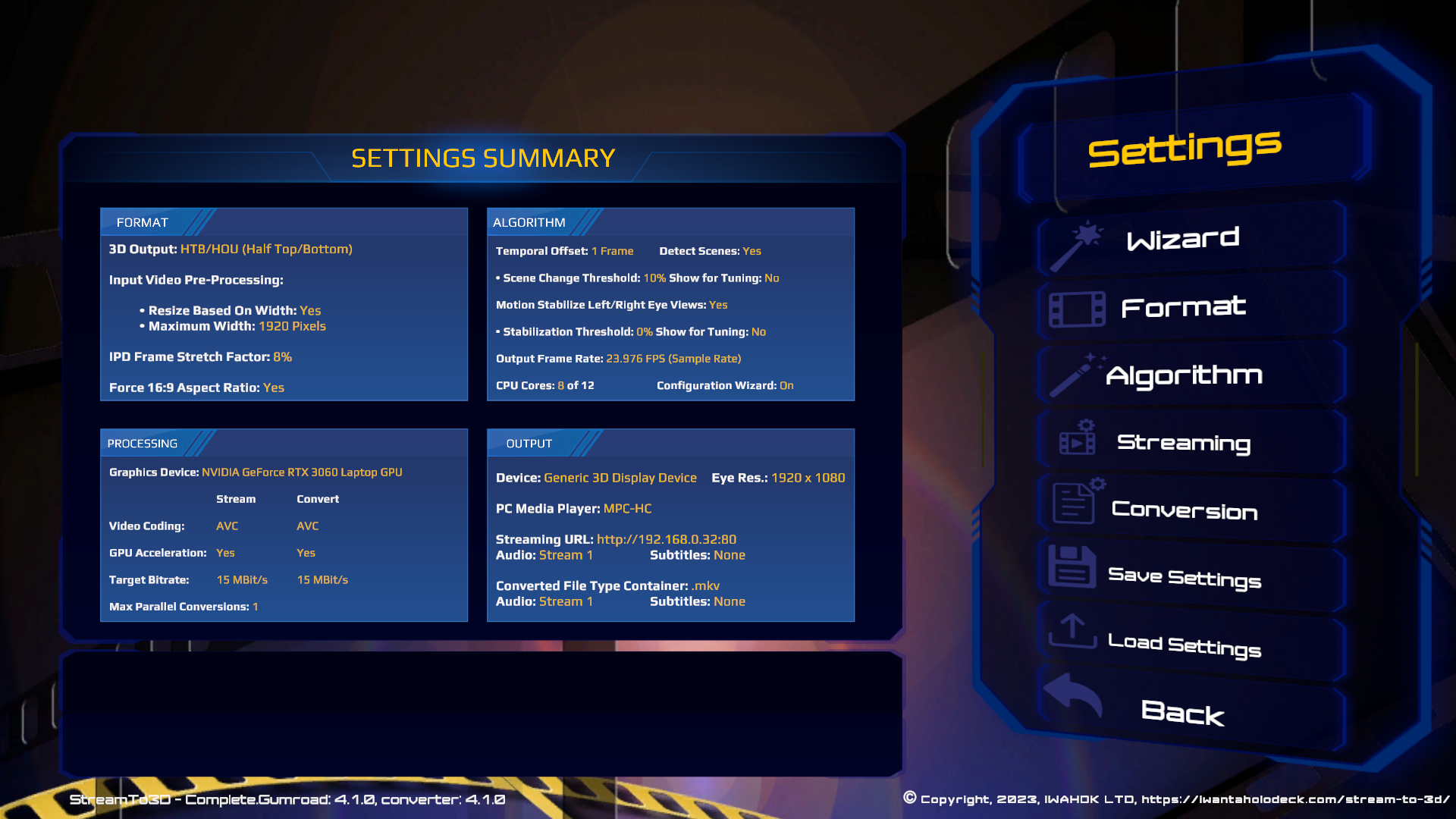
Settings - Wizard
Release 4 introduced the Configuration Wizard. The behaviour of the Wizard can be controlled from the Settings/Wizard menu option, which displays the selections below.
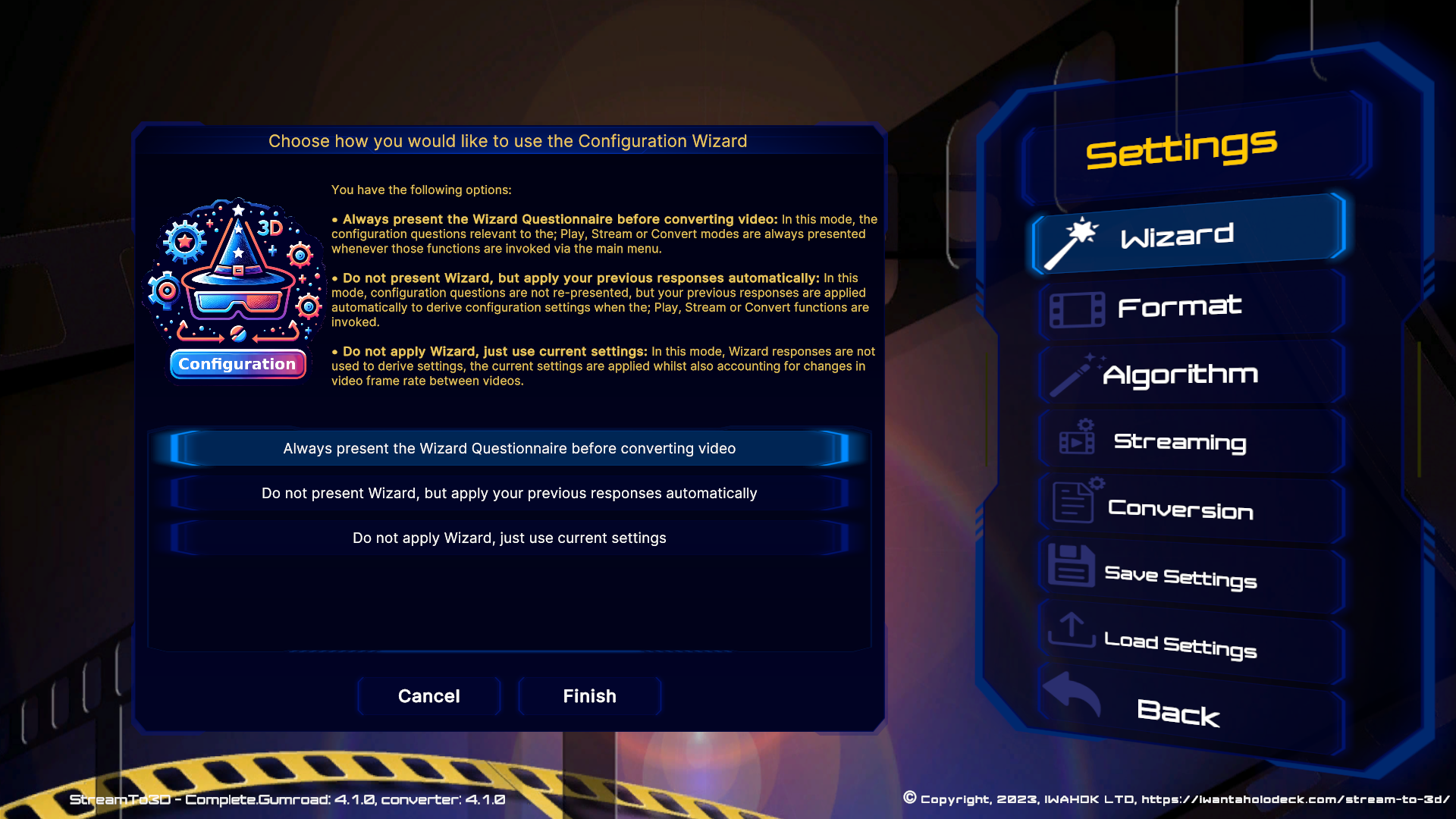
As indicated, you have the following options:
• Always present the Wizard Questionnaire before converting video: In this mode, the configuration questions relevant to the; Play, Stream or Convert modes are always presented whenever those functions are invoked via the main menu.
• Do not present Wizard, but apply your previous responses automatically: In this mode, configuration questions are not re-presented, but your previous responses are applied automatically to derive configuration settings when the; Play, Stream or Convert functions are invoked.
• Do not apply Wizard, just use current settings: In this mode, Wizard responses are not used to derive settings, the current settings are applied whilst also accounting for changes in video frame rate between videos.
The behaviour of the Wizard, when Play, Stream or Convert is selected from the Main Menu is described at the links below:
Settings - Format
The Format settings page provides control over the 3D video file output format from Stream to 3D and the file name format that is recognised by Stream to 3D as representing a 3D video file. The same settings are applied for real-time playback, streaming and file conversion.
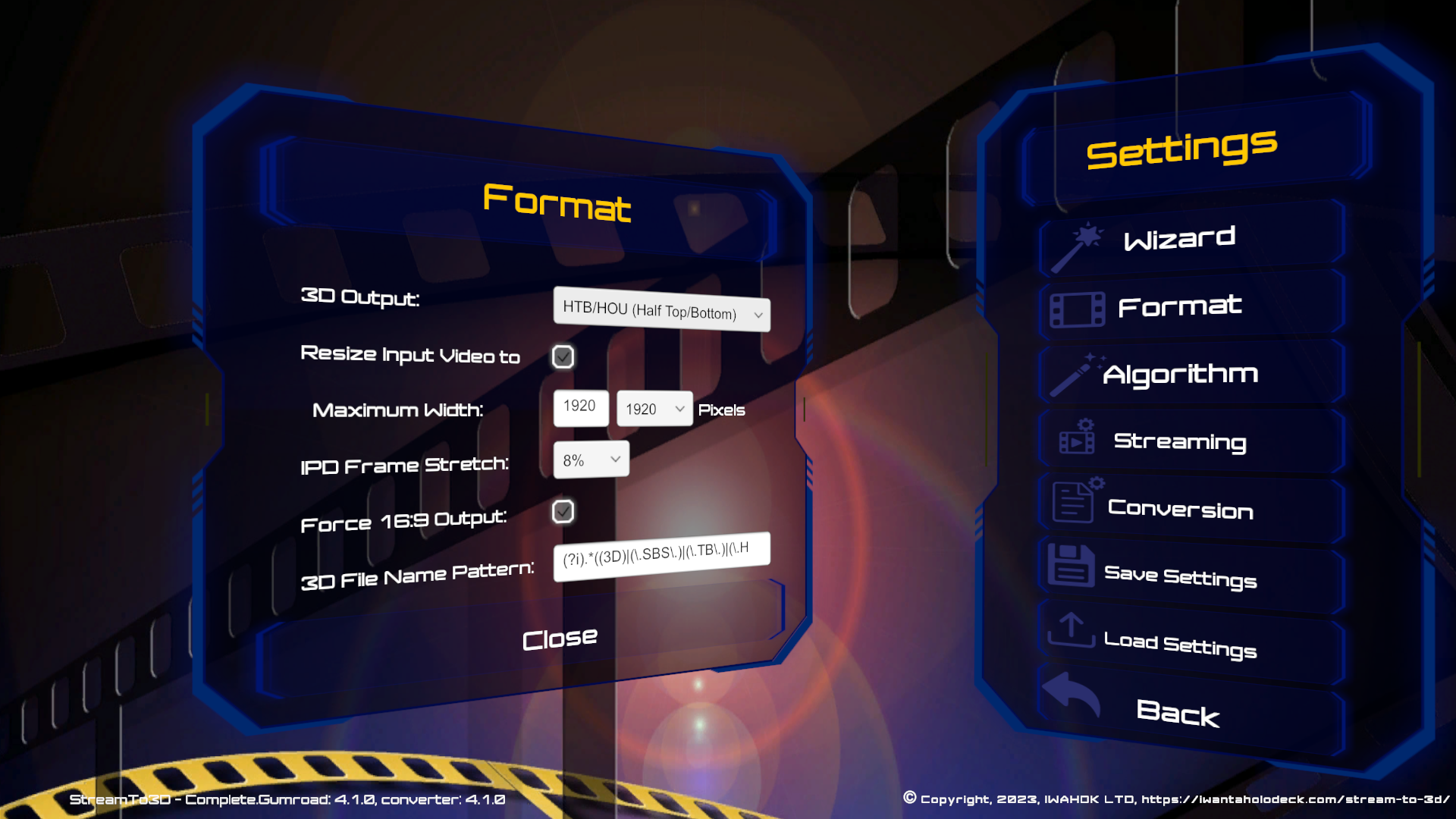
The 3D output drop-down list allows selection of a number of different 3D output formats:
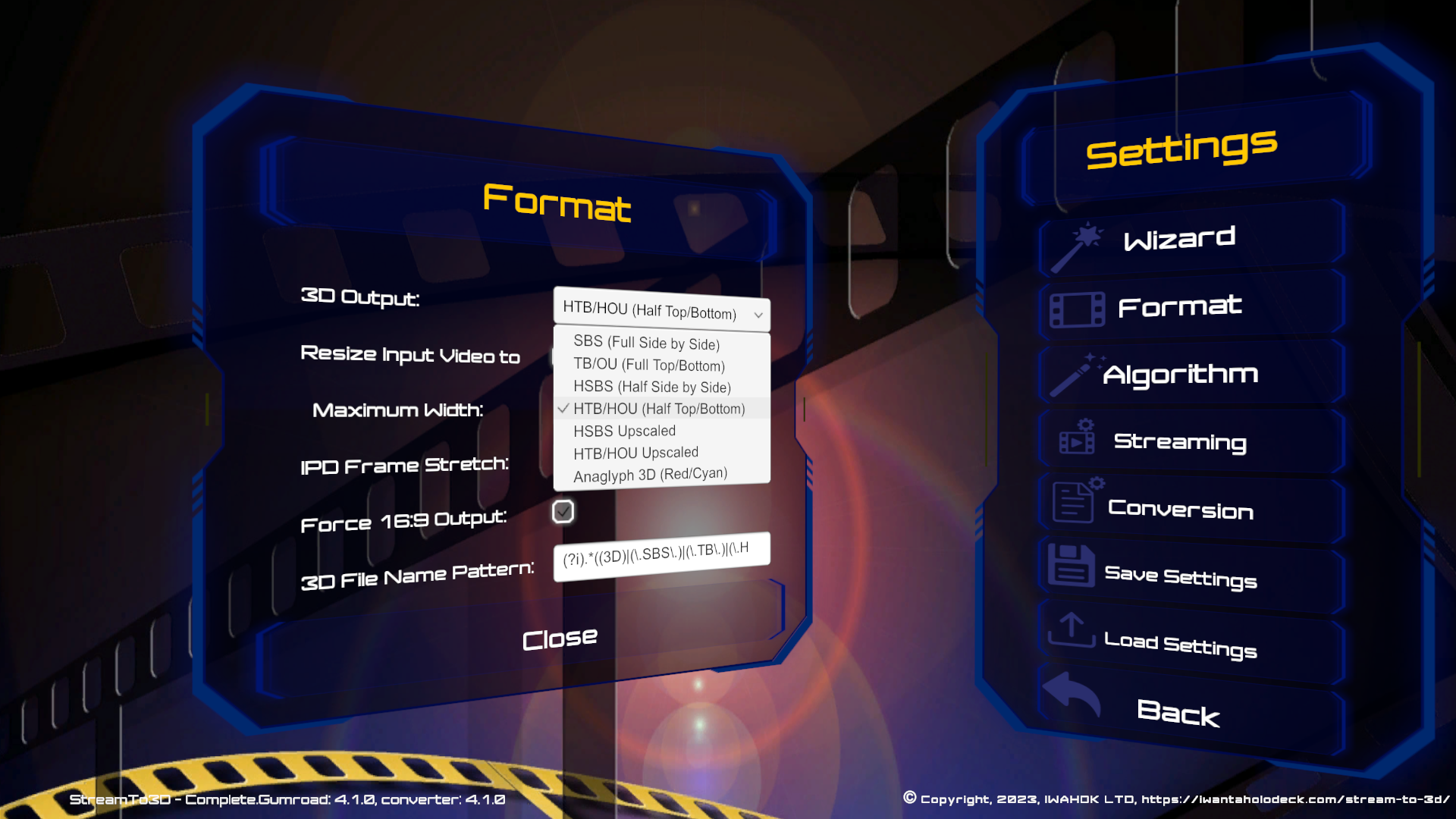
- SBS (Full Side by Side)
- TB/OU (Full Top/Bottom)
- HSBS (Half Side by Side)
- HTB/HOU (Half Top/Bottom)
- HSBS Upscaled
- HTB/HOU Upscaled
- Anaglyph 3D (Red/Cyan)
The "HSBS Upscaled" and "HTB/HOU Upscaled" formats require a little more explanation. HSBS Upscaled outputs the video in HSBS format, but upscales the video so that it has the same resultant resolution as Full SBS, by retaining the horizontal resolution of the original video and doubling the vertical resolution. Similarly, HTB/HOU Upscaled retains the original vertical resolution of the video, but doubles the horizontal resolution. This is for compatibility with devices/media players that only support Half SBS/TB formats. However, the trade off in increased quality is an increased demand in terms of machine resources.
Anaglyph 3D (Red/Cyan) provides the 3D output in a format that can be displayed on a 2D device and viewed with Red/Cyan glasses.
The preset configurations supplied with Stream to 3D for Virtual Desktop and BigScreen Steam VR use a format of SBS (Full Side by Side) for Virtual Desktop and HSBS (Half Side by Side) for BigScreen. If your system can handle it, you could experiment with the Upscaled formats for BigScreen.
The "Resize Input Video to..." checkbox option allows you to optionally resize the resolution of a 2D video before it is converted to 3D. This is usually to scale down very high-resolution videos (e.g. 4K) before conversion, particularly if they are higher resolution than would be supported by the target device.
The value entered or selected in the "Maximum Width" edit box or drop-down list is applied if the "Resize Input Video to" checkbox is ticked. In this case the input 2D video is resized to the width selected, before 2D to 3D video processing is applied. You can think of this as the maximum target, per eye resolution of the output 3D video. The output video may actually end up with a lower horizontal per eye resolution than this if the "Force 16:9 Output" option is selection, as aspect ratio correction may in some cases crop the video further after the intial resize pre-processing is complete. As a guide, note that the maximum per eye resolution of the Meta Quest 2 VR headset, for example, is 1,832 × 1,920 pixels and for the Meta Quest 3 it is 2064 × 2208 pixels per eye. VR headsets have a variety of resolutions, see here for details.
The "IPD Frame Stretch" factor allows tweaking of the depth effect. You can increase the value to heighten the depth effect, but setting it too high will cause the effect to break down and introduce distortion. It is also related to Interpupillary Distance, so if the 3D view is not comfortable for you, try adjusting this stretch factor.
When the "Force 16:9 Output" check box is used, Stream to 3D will change the aspect ratio of 3D output videos to 16:9 by automatically cropping in the vertical or horizontal direction to achieve the required aspect ratio. Many output devices have a fixed standard 16:9 aspect ratio, this option can be used to better support such devices.
The "3D File Name Pattern" item allows maintenance of the pattern used by Stream to 3D functions to determine whether a file is in 3D format. See here for further details.
Settings - Algorithm
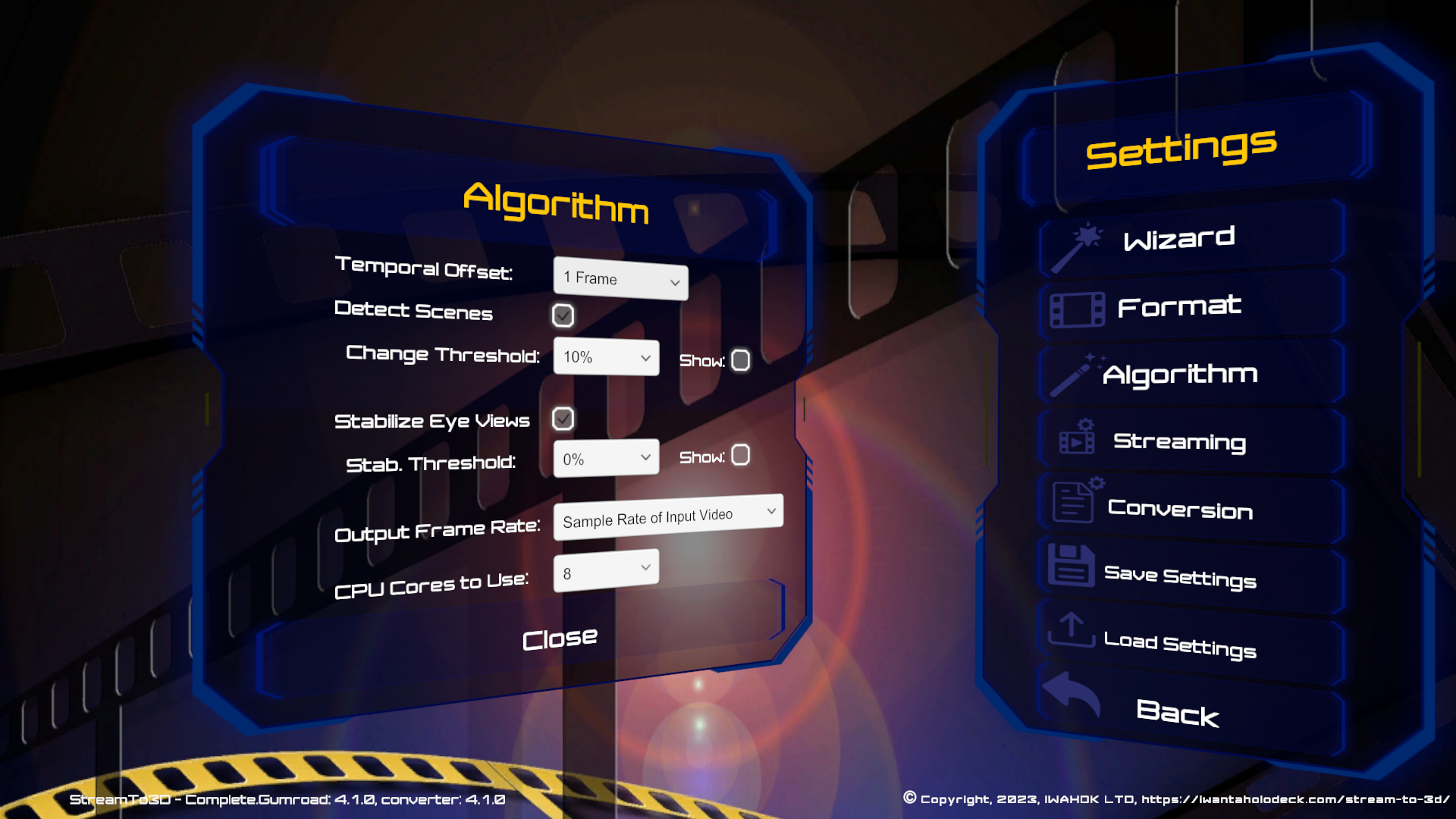
For background and further reading on the algorithm used by Stream to 3D, see here. Several significant enhancements to the base algorithm are implemented in Stream to 3D to enhance the effect and eliminate discomfort. These are described here and here. The Algorithm settings in Stream to 3D allow fine tuning of the algorithm.
The Temporal Offset and Stabilize Eye Views (together with the Stab. Threshold) settings are key to controlling the 3D Effect. A set of example videos with different illustrative settings are provided here.
The "Temporal Offset" is fundamental to controlling the depth of the 3D effect produced by Stream to 3D, relying on the Pulfrich Effect, a phenomenon that manipulates visual perception through the introduction of temporal disparity.
The default temporal offset is 1 video frame. However, this can be tweaked to increase or decrease the effect to best suit your viewing preferences.
The default temporal offset produces a subtle and gentle 3D depth effect (corresponding to the Subtle option in the Configuration Wizard) that adds a touch of 3D dimensionality without overwhelming the visual senses.
A temporal offset of 1.25 Frames produces a balanced 3D depth effect (corresponding to the Balanced option in the Configuration Wizard) with a noticeable depth that enhances the visuals with more pronounced 3D dimensionality.
A temporal offset of 1.5 Frames produces a more intense and striking 3D depth effect (corresponding to the Intense option in the Configuration Wizard) for a more immersive viewing experience.
Note that temporal offsets other than whole numbers, e.g. 1.25, are significantly more CPU demanding (as they rely on frame rate interpolation). Depending on the capabilities of your system, you may not achieve real-time conversion for fractional values.
The "Detect Scenes" checkbox enables or disables scene detection. The base algorithm breaks down at scene transitions and causes discomfort to the viewer. As discussed here, enabling this setting effectively eliminates the impact of scene transitions.
The base algorithm can also potentially introduce discomfort when there is large scale rapid movement, characterised by large scale visual changes between frames. This is similar to a scene transition and so the same mechanism introduced to eliminate the impact of scene transitions also addresses large scale rapid motion between frames. The "Threshold" setting determines the percentage of the frame that needs to change before it is treated as a large scale rapid motion change. The 10% default has been determined as effective for a wide range of videos, but it can be tuned if necessary using the "Threshold" drop-down percentage value.
The "Show Detected" checkbox is provided to assist tuning of the scene detection "Threshold" value. When the "Show Detected" checkbox is checked, the 2D to 3D conversion process will turn the right eye view pink at detected scene transitions and when large scale rapid motion is detected. Viewing the video with this enabled will allow you to increase of decrease the threshold to your tastes. However, the default value works well for the vast majority of cases.
The "Stabilize Eye Views" checkbox, enables or disables the algorithmic enhancement described here, in terms of Motion and Alignment. Enabling this item has a very significant effect in reducing discomfort, but also dampens the 3D effect somewhat. You can adjust this setting to your taste via the Stabilization Threshold setting. A threshold of zero percent is the maximum comfort level, to enjoy the 3D experience with maximum stabilization, minimizing eye strain and motion discomfort. A threshold of 0.5% supports an immersive experience with enhanced depth and moderate stabilization for a more engaging visual experience that maintains comfort. Disabling stabilization provides a more wild and intense experience with the added risk of some discomfort.
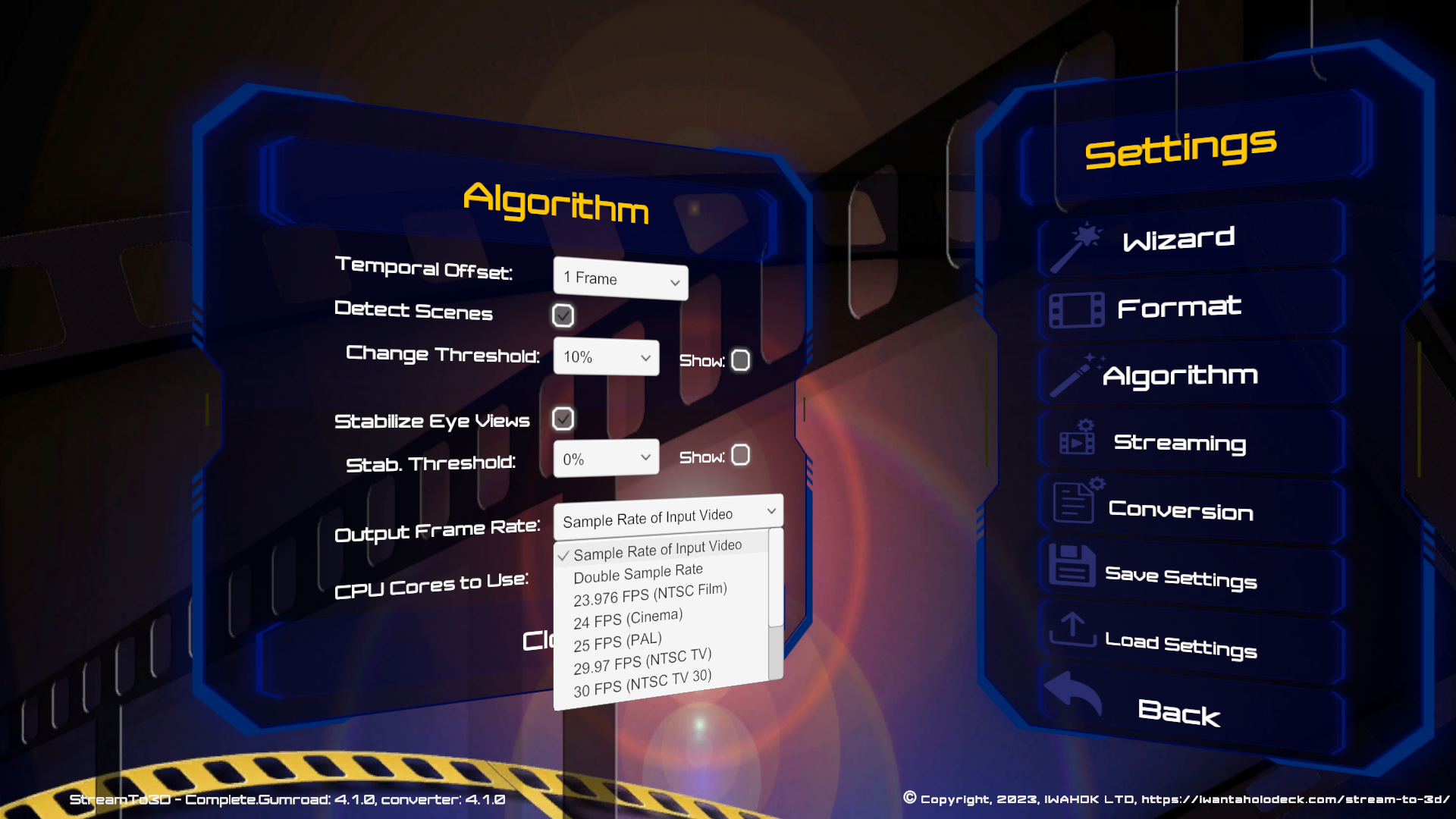
The "Output Frame Rate" setting allows you to set the output frame rate following 2D to 3D conversion. The default output frame rate is sourced from the rate at which the input video is sampled for 3D conversion (called the Sample Rate). For a movie/film, this is typically 23.976 Frames Per Second, but will vary based on the standard used to produce the original video (e.g. 25 FPS for the European PAL TV Video Standard). Stream to 3D will, by default, automatically apply an output frame rate based on the Sample Frame Rate of the input video. Alternatively, you can set Stream to 3D to double the frame rate of the video, via frame rate interpolation or set a specific frame rate from the values available in the drop down list. Note that the Configuration Wizard will automatically double the frame rate of the input video for you, when the Maximum Quality option is selected.
Frame rate interpolation is used to generate intermediate frames for all but the default of "Sample Rate of Input Video". Frame rate interpolation is a very resource intensive process and it is unlikely that you will be able to achieve real-time conversion for the higher frame rates, particularly for full frame 3D output on high-resolution videos. However, these rates can be successfully applied for off-line conversion.
The default frame rate is obtained by sampling the source video at the determined "Sample Rate" rather than performing interpolation, so there is no frame rate interpolation overhead at the sample rate.
Note the "CPU Cores to Use" item. Stream to 3D automatically detects the number of CPU cores on your machine. By default it will set the number of "CPU Cores to Use" for conversion, streaming and playback to half the number of CPU cores available. This is to reduce the risk of Stream to 3D processing impacting other processes running on your machine. You can experminent with this value.
Settings - Saving Configurations
You can save Stream to 3D configurations settings for distinct purposes in different config files, using the Settings/Save Setttings menu option as shown in the screen shot below and reload them again with the Load Settings option. Note that you cannot save settings in the StreamTo3D application folder as this is protected, use a sub-folder of your Documents folder or Desktop:
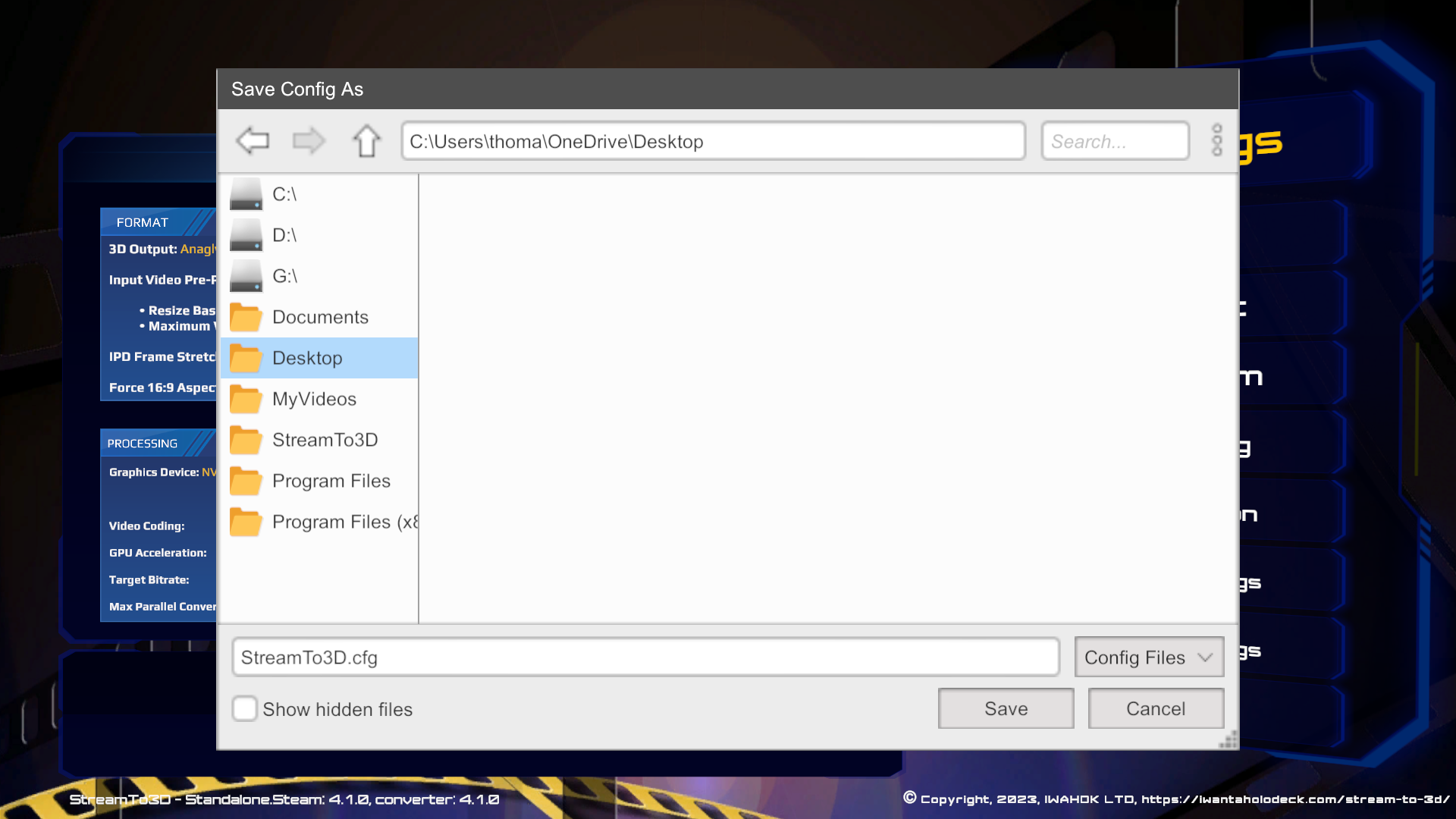
You can edit the name of the settings save file to suit your purposes.
Settings - Loading Configurations
You can load previously saved configurations via the Stream to 3D Settings/Load Setttings option.
In addition, Stream to 3D is shipped with a number of pre-defined config files for different purposes. To a large extent these have been superseded by the Configuration Wizard. To find these, click on the StreamTo3D short cut in the left hand pane (as shown highlighted below):
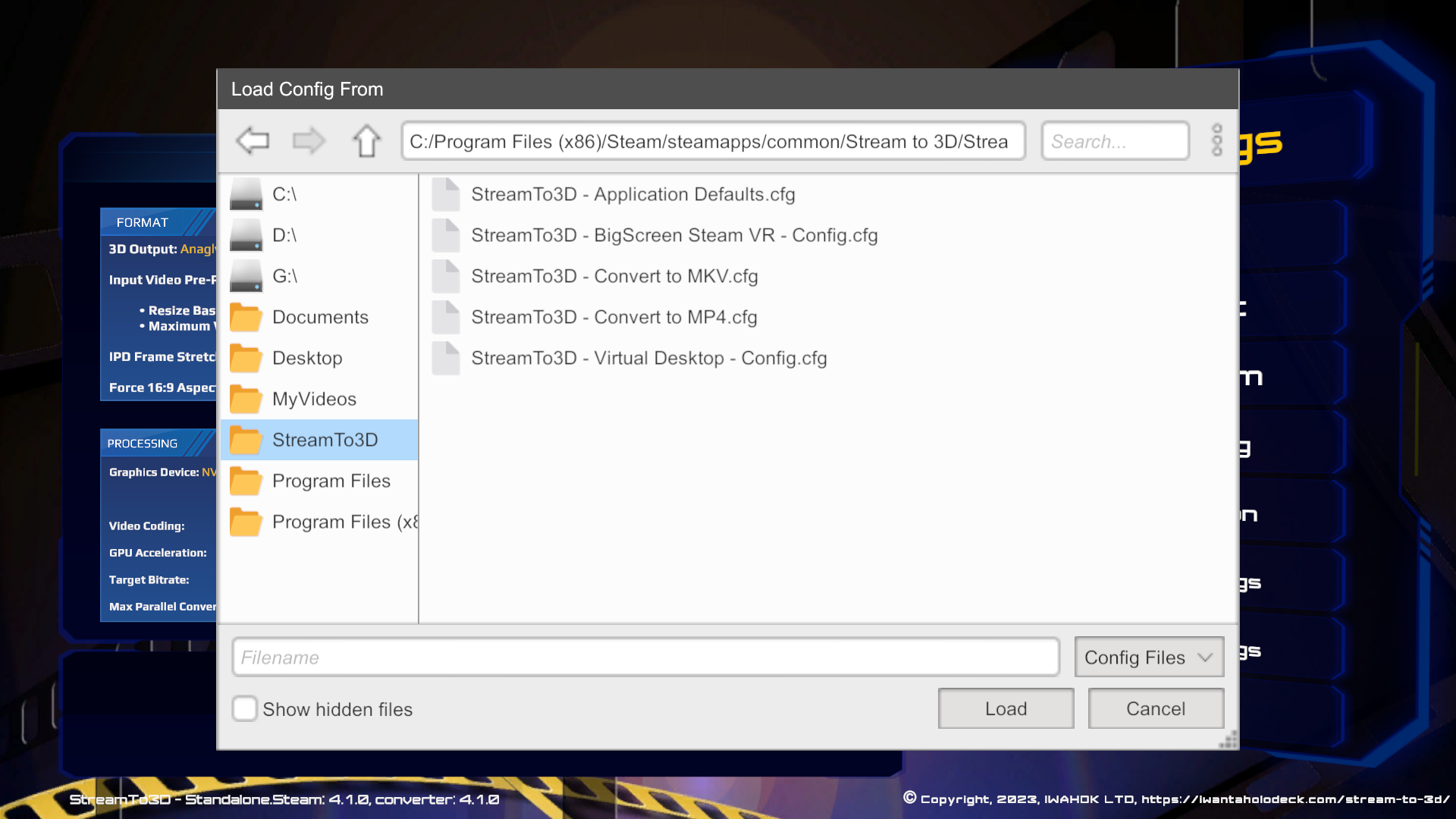
Settings - Resetting Stream to 3D to its Default Settings
The "StreamTo3D - Application Defaults.cfg" config file is very useful for resetting Stream to 3D to its defaults (see previous section "Loading Configurations" to locate this file).
Note that resetting by this method does NOT reset the established folder locations for installed tools, as these are discovered automatically on initial install. However, you can change the installed tool locations manually if you need to via the Main Menu/Tools option.
In addition, if you have uninstalled Stream to 3D and removed the tools (and/or the application installation folder). You may need to follow the guidance below to re-install the tools:
Re-installing Tools if Stream to 3D was Purchased from the Steam Store:
There are two ways to re-install the tools/dependencies if Stream to 3D was purchased from the Steam store:
1.) Run this program:
C:\Program Files (x86)\Steam\steamapps\common\Stream to 3D\StreamTo3DToolsStandalone-SteamSetup.exe
During the setup, you can then choose which tools to install/re-install. This program gives you full control over the tools installed. You can select to install all of the tools or a subset, including the K-Lite-Codec pack which comes with MPC-HC. All of the tools (except PotPlayer and VLC) will be installed under this folder:
C:\Program Files (x86)\Steam\steamapps\common\Stream to 3D\tools
2.) The reason that the Steam store does not automatically re-install the tools for you, is that it sets a flag in the registry after the first installation of Stream to 3D to say that the tools have been installed. It does not automatcally clear this flag if you un-install Stream to 3D - so they do not get re-installed with Stream to 3D. If you are happy to do so, you can reset the Windows registry entry yourself and then the Steam store will re-install the tools for you (silently) when the Stream to 3D application is re-installed. It will use the program referenced in 1.) above to do this. To make this happen, find the registry key:
HKEY_LOCAL_MACHINE\\Software\\Valve\\Steam\\Apps\\2494510\\StreamTo3DTools
And change its value from 1 to 0. When you re-install Stream To 3D, it will then automatically re-install the tools.
Settings - Tools
The Tools configuration settings can be accessed from the Tools option in the main menu. This short cut makes it quicker to switch media players, for example.
It is best to check that the Tools configuration is correct following first installation or upgrade to make sure that everything has been correctly discovered and configured, clicking on the Tools item in the main menu takes us to the screen below:
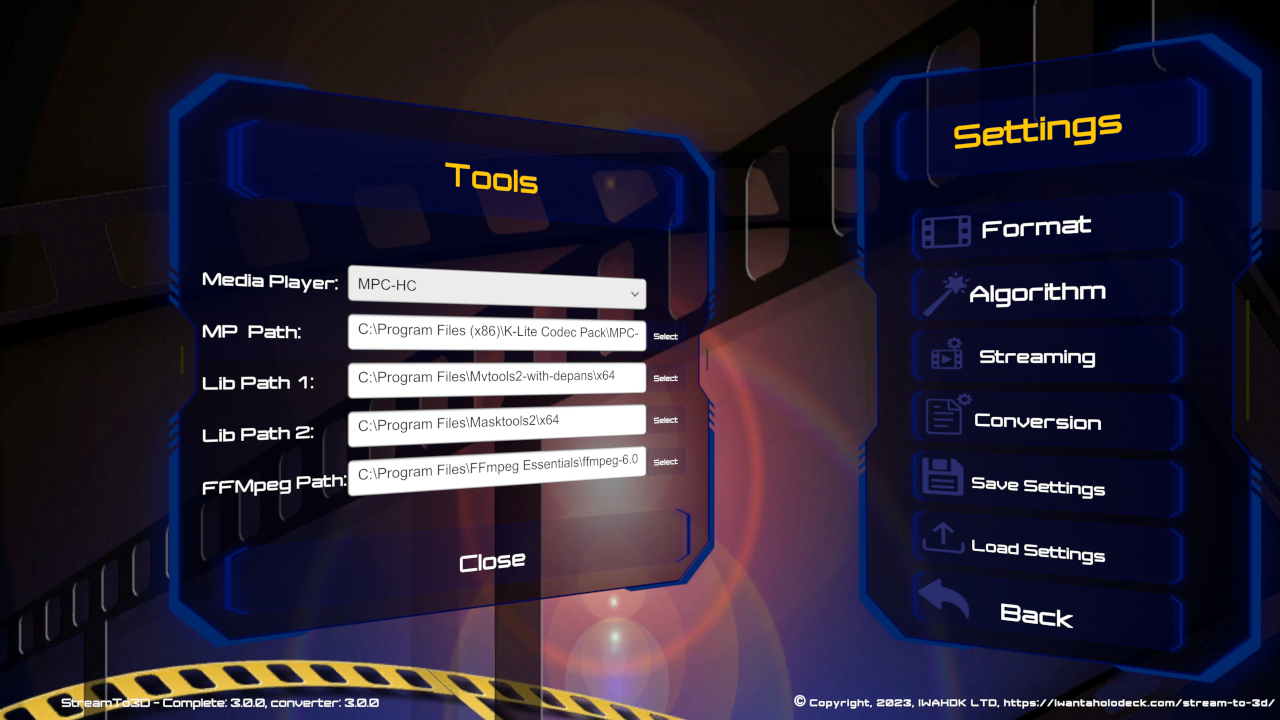
If you had some of these tools installed before installing Stream to 3D, make sure that the paths that appear in the path selection boxes are correct. Stream to 3D uses the registry settings of these tools to determine their installed locations, if they are incorrect then you can change them accordingly.
Settings - Tools - Media Players
If you have any of the supported media players installed, you can use the Media Player drop-down to change the current Media Player (and so the install path displayed - labelled as MP Path) and edit the path as necessary. The Media Player selected is also the one that will be used when you hit the "Play" main menu button to play a video through Stream to 3D, which will be automatically converted to a 3D format:
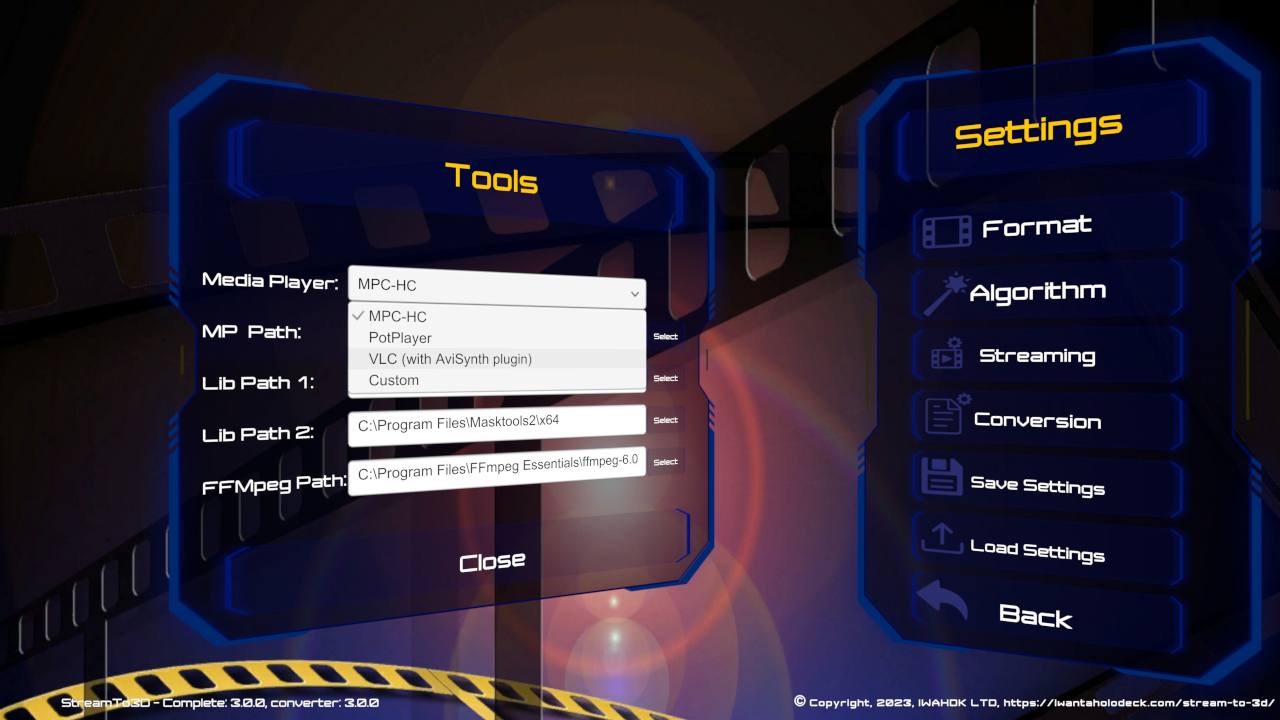
As an example of configuration of other media players, this is the view with PotPlayer installed and selected:
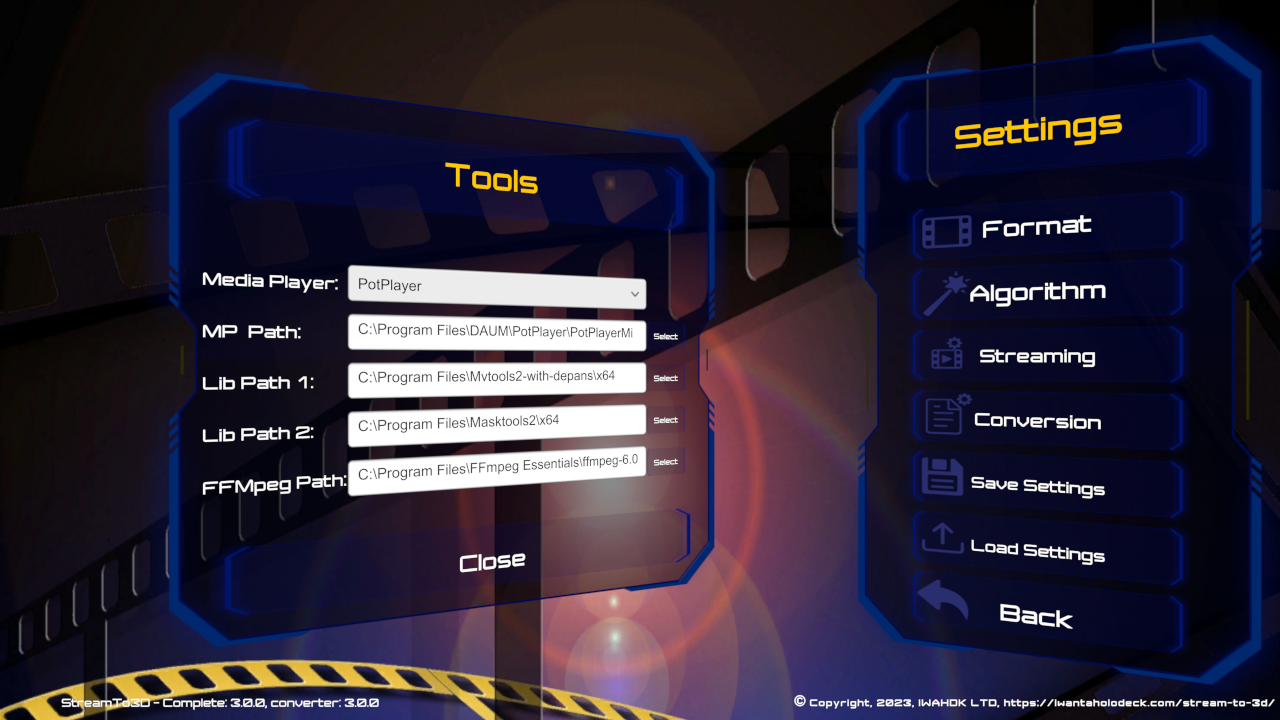
You can also specify a "Custom" media player and the path to its ".exe" file, but the custom media player must be able to accept ".avs" files as input.
Settings - Tools - Libraries
The libraries (shown on Lib Path 1 and Lib Path 2) assist with scene and motion detection during 2D to 3D conversion. They are not absolutely required, but the quality of the 2D to 3D conversion will be enhanced significantly when they are available.
Settings - Tools - Video Streaming and Conversion [NA for Real-Time product]
The FFMpeg tool is used for video streaming and during off-line video conversion. The latest version of FFMpeg is downloaded during Stream to 3D installation, if selected. Check that the installation path is correct, particularly if you are using your own version of FFMpeg.
Stream to 3D auto-detects whether you have an Nvidia or AMD GPU and, if enabled, will use the appropriate FFMpeg settings for GPU accelerated video encoding to either H.264 or H.265. For details of configuring FFMPeg for Streaming and Conversion, click here.
Important: For GPU accelerated video encoding, FFMpeg has a dependency on your GPU graphics driver, so you need to make sure that your GPU graphics driver is up to date. You will receive an error from Stream to 3D, telling you to upgrade your graphics driver, during video streaming or conversion if there is a mismatch.
Click here to go to the Usage and Configuration home page.